Tours
Partner Tourism Agency

Tour Agency: Natal Vans
http://www.natalvans.com.br/
natalvans@natalvans.com.br
+5584 3642-1883
NatalVans will also keep a stand in HC'14 venue, for touristic pack acquisitions presentially.
Part Time Tours:
1. City Tour (with the largest cashew tree in the world) - Daiy Departures
1.1 MORNING
Price per person: R$ 50.00 by credit card / R$ 45.00 by cash
Description: A chance to meet the main sights of the Natal's city, with itinerary including: city's main beaches, Historic Downtown, Ponta Negra, the Blasted Lands, the largest cashew tree in the world, various crafts and restaurant options. Stop in
Fortaleza dos Reis Magos (Kings Magos Fort). Length: ½ period.
1.2. AFTERNOON (boat - sunset included)
Price per person: R$ 60.00 by credit card / R$ 50.00 by cash
Description: A chance to meet the main sights of the Natal's city, wirh itinerary including:
- City's main beaches
- Historic Downtown
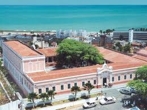
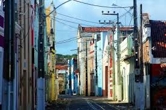

- Ponta Negra

-
Barreira do Inferno
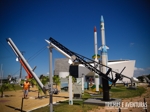
- Largest cashew tree in the world, various crafts and restaurant options
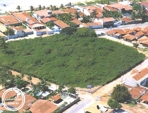
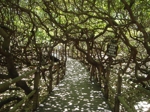
-
Natal's Aquarium

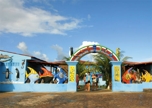
Length: ½ period.
(*) Note .: On Wednesday afternoon and Thursday morning the Fortaleza dos Reis Magos not open.
Optional: entriance in the largest cashew tree in the world,
Fortaleza dos Reis Magos and in the aerospace museum
Barreira do Inferno (barrier of hell).
2. North Coast buggy - DAILY DEPARTURES
Price per buggy: R$ 360.00 + 25.00 fee ferry cash (buggy with seating for 4 people)
Itinerary: Output buggy hotel, passing by several beaches and lagoons. An unforgettable tour. Natal has always been known for its dunes that provide great emotions.
- Natal's aquarium
- Santa Rita
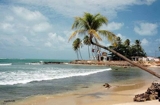
- Genipabu beach, where we find the dromedaries.
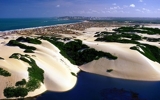
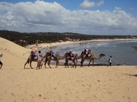
- Crossing the ferry at
Barra do Rio and arrived in Golden Dunes and Pitangui lagoon, with a 40min stop on average in the lagoon bar


- Dunes and lagoon Jacumã, to meet skybunda optional and aerobunda and had lunch in a restaurant the seaside.
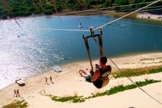

- Depending on the tide, stretched the ride to Porto Mirim and Muriu and then returning to Natal.
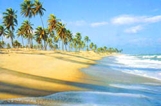

Duration: 4h30.
Optional: Dromedary, Aerobunda and Skybunda.
*** Rates ferries are not included ***
3. Quadricycle - DAILY OUTPUT
Price per quadricicle: R$ 150,00 card or cash for quad bike (up to 02 people)
Description: The tour begins at the border of Forest Nísia with Melbourn. All instructions are given before the tour, knowledge about the nature and ATV. The first stop is in the pond of licorice, for photos and enjoy the visual. Soon after comes the slide (with track undulations), and then the Yellow Pond. Whole script accompanied by instructor.
Duration: Approx. 2:30, transfer included.
Note: For other tipes of tours, contact direclty NatalVans Agency by email or telephone. They will also have a stand in HC'14 venue, for touristic pack acquisitions presentially.
natalvans@natalvans.com.br
+5584 3642-1883
---------------------------------------------------------------------------------------------------------------------------------------------------------------------------------------

Until relatively recently, Rio Grande do Norte was virtually unknown to foreign visitors. All that is changing, with the state's many attractions catching on fast. Here, you can breathe in the cleanest air on the American continent, or samba along to the sounds of its famous carnivals. Perched on the most north-easterly tip of Brazil, Rio Grande de Norte is packed full of tourist attractions, from medieval fortresses to natural monuments.
When 17th-century sailors came across the coastline of Rio Grande do Norte, the first thing they probably saw was the Forte dos Reis Mago, an impressive fortress built by the Portuguese shortly before they founded what is today the state capital of Natal.
The first impression that today's tourists get of Natal is more likely to be one of its legendary beaches. They include Ponta Negra, with its iconic sandy dunes. Likewise, nearby Pipa Beach, once a small fishing village, has been transformed into a backpackers' and surfers' paradise. Tourists clamber onto the back of Genipabu's famous dromedaries to explore its picture-postcard dunes and admire the crystal-clear waters of the lagoons here.
Opportunities to don fancy costumes and take in the sheer spectacle of partying folk and fireworks are plentiful. Every December, Natal's streets echo to the sounds of the out-of-season Carnatal, with its 'trio elétrico' trucks. The Saint John's Day festivities are just as popular.
Venture inland from Natal and the landscape soon turns into something quite different and much more dramatic. The Vale dos Dinossauros, near the city of Sousa, and Lajedo de Pai Mateus offer a glimpse into the state's fascinating past.
The world's largest cashew tree can be spotted in Rio Grande do Norte. Over 1,000 years old, the North Pirangi landmark is reputed to cover the area normally occupied by 70 average-sized cashew trees.
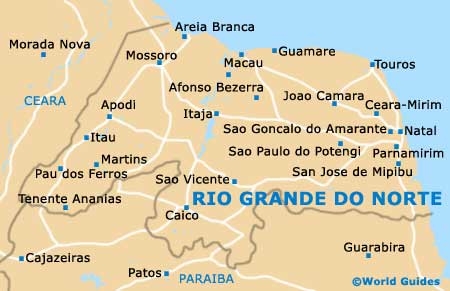
Natal is the main administrative centre of Rio Grande do Norte, and it is not only known for its natural beauty, and its history is proof of this. The city has already been fought over by the French, Dutch and Portuguese, and during the Dutch Occupation period it was known as New Amsterdam. Furthermore, it played an important role in the Allies' victory in World War II because of its geographical proximity to both Africa and Europe. It is currently an important tourist spot.
The city, nowadays known as the Bride of the Sun, did not get this name by chance: the sun shines for around 300 days a year and it is perfect both for those that enjoy fun and for those that just want to rest, because it offers attractions that fit the tastes of all its visitors.
GASTRONOMY
By its privileged geographic location the state of Rio Grande do Norte margining the Atlantic Ocean has a culinary divided in regional products and seafood. Among the food variety consumed in many centuries by the native people, in the countryside are the one derived from livestock activity: sun meat, paçoca (ground and toasted meat), some kinds of cheese, curd etc. It’s also common the foods prepared with regional products like cassava, maize, coconut and many others.
Natal disposes a diversified culinary shared in numerous restaurants and bars, from the most sophisticated to the most simple, both offering high quality in gastronomy and excellent assistance. There are also many Italian and Japanese restaurants. The city offers 500 choices of restaurant and 300 bars turning the night hot and spread the offer of entertainment and leisure of Natal.
NIGHTLIFE
Natal night holds lots of gifts to the tourists with high level nightclubs. The tendencies reigning the nocturnal potiguar live are well diversified. They range from techno to Latin music and rock’n’roll, which contradicting the local culture it´s a local passion too.
The most of the nightclubs in Natal including the new generation ones lies in the Ponta Negra district, but also has good alternatives in Petrópolis, regarded as the high capital district, and in the Ribeira district, portuary zone margining Pontengi river, and it is there that is lying the oldest big houses in the city.
Morro do Careca, a sand dune, is the symbol of the potiguar tourism and the culminating point of the Ponta Negra district, and gained tons of cosmopolitans starting from the beach that give it its name. Restaurants, nightclubs, bars with live music make the nocturnal live get hot. The landscaping charm drawn the visitor and invite him to enjoy all the interesting attractives of the Ponta Negra night.
Natal also disposes a multicultural calendar of festivity events. Among the main events, we have the Carnatal, a festival that is already part of the national calendar and do the Summer season opening in Natal. During the four days of the event 40,000 tourists join the millions of reveller, a grandiose number in a grandiose festival.
CULTURA
The union of three ethnic group founders of the Brazilian people – the black, the American Indian, and the Portuguese – mixed with the Dutch immigrants makes the origin the people of the Rio Grande do Norte.
The diversity cultural influence is present in the popular events and in the potiguar folklore, going from processions to vaquejada, and typical dances like forró, stylized quadrille and Bumba-meu-boi. Viola singers, cordelistas (people who write small histories), repentistas (improvisators), emboladores and dance groups that narrate the potiguar people history are the most outstanding presence of this culture, which is one of the richest in the Northeast.
Great representative of the potiguar capital culture Natal disposes the Ribeira district, which since the start of its foundation is a heterogenic aggregation of poetry, history, architecture, myths and people. Its elements foundations concentrated in a single geographic space generate an extraordinary and deeply rich in culture, human species, legends, majestic buildings place and a singular matter in the city urban development.
Rio Grande do Norte presents lots of cultural activities among handicraft, arts and handicraft exhibition, popular traditional expression exhibition, movie festival; musical festivals; dance festival and dance and music contest, and sporadically, movie festival. “Broidery” as the most present handicraft activity, as well the theater groups and libraries, are the cultural segments that receive grant part of the “support” from the city halls in the nation general context.
MAIN ATTRACTIONS IN NATAL
CITY TOUR
Driving by the coast way, we´ll pass by the 2nd biggest green urban park of this country, the biggest hotel of the city, Mother Luíza lighthouse, Areia Preta, Artistas, Meio and fortress beaches. We will also visit the fortress built by the Portuguese and the Dutch soldiers. From the fortress we have a view of the old hydroplanes base built by the Americans during the Second World War, which is nowadays a museum of Getúlio Vargas and Frankling Rosevelt. Further by the old town “Ribeira”. On our way we´ll see the Alberto Maranhão Theater, the art captaincy, André de Albuquerque Square, Câmara Cascudo Museum, the Metropolitan Cathedral and The Three Power Square. Then we reach the center of the city. Our next stop will be at the “Centro de Turismo” a handcraft centre located in an old prison built by the Portuguese during the colonization of Natal. After all this we continue by the modern side of Natal, passing by Petrópolis, Tirol and Lagoa Nova Neighborhood where is the new gymnasium Arena das Dunas, where were the matches on The 2014 FIFA World Cup. On the way back to Ponta Negra we will visit the gem stones lapidary which is a very important activity for the economy of Rio Grande do Norte and Brazil.
The Fortress
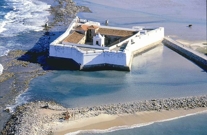 |
It is the most important monument of the city and became a national historical patrimony. Its construction was started in 1598 and was occupied by Dutch between 1633 and 1654. Its shape remembers a five point star. It has a chapel with a fresh water well, barracks and old cannons and holds the mark of the discovering and offers guided visits.
|
Cashew of Pirangi
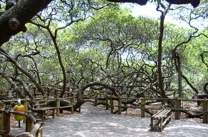 |
The biggest cashew of the world has a canopy of 8,400 m2. Researches show that the enormous tree is consequence of a genetic aberration. Fenced preventing it from continuing growing, it produces 60,000 cashews per harvest and in its surrounds it can be found small gifts stores.
|
Touristc Center of Natal
 |
Former Casa de Detenção (a prison), it offers handicraft stores. It can be found there items like rabbet of Luzia Dantas, female handcraft from Currais Novos and Gregório. The potiguar handworks are made of wood. It also offers clay and ceramic works originated form Caruaru, in Pernambuco. Every Thursday it promotes the “Forró com o Turista” at 10 PM. |
Chile Street
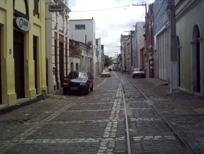
|
Chile Street, once known as Alfândega e do Comércio Street, was one of the most important streets of Ribeira district in the beginning of the XIX century. Beginning on 1850, it was build with stone and lime buildings, which the most of then was storehouses designated to receiving cotton, sugar, tatajuba (regional fruit from the mid region of Brazil) and fresh fish, among others goods. The street concentrates houses and buildings that by its historical value and architecture traits actually constitute the Historic Preservation Zone. In it can be found the building where once operate the Government Palace – 1892-1902, and received the Count D’Eau, consort of the Princess Isabel. Built in the neoclassic style it was the higher loft in that time, a tree floors building. There also can be found the house where lived Câmara Cascudo and later belonged to the poet Ferreira Itajubá. Actually it shelters various attractions connected to culture like music, dance and theater. |
Parque das Dunas
 |
Second biggest urban park in Brazil, the Parque das Dunas is opened from Tuesday to Sunday. Its area is 1,172 hectares and provides observing diverse vegetal and animal species exclusive from Atlantic forest (the park shelters one of the last areas of Atlantic forest of the State). Observing can be made through tracks with trained guides.
|
Barreira do Inferno
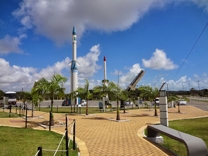 |
The construction of the Barreira do Inferno complex started in 1964 near the Ponta Negra beach at 17 km from Natal downtown occupying a area about 5 km2 where inside it was about 30 modern architecture building with asphalted roads and efficient lighting system. The complex has pads for the launching of various kind of rockets, fuel and rocket deposits, plus one sophisticated meteorological and another for launching of meteorological balloons. It relies on tracking scanners and telemetry, the reason Natal is called Brazil Space Capital. It is the first rocket launch base in South America and the fourth with a worldwide important.
|
TOUR OPTIONS AROUND NATAL
MARACAJAÚ SNORKELLING
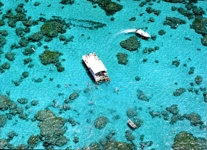
|
65 km north of Natal. We will cross the whole city towards the north shore passing by all the beaches, this time by the main road BR 101. Reaching Maracajaú you will see the big contrast between the city and this small fishing village. This place is most known because of it´s coral reefs located 7,5 km from the coast. The total coral reef area is about 14 km2, this area is totally preserved, home for many kinds of sea life such as big barracudas, lobsters, parrot-fish, octopus, rays, sea-leazards, morenas and other thousand different kinds of fish and crustaceans. So is Maracajaú, the temperature of the water at the corals can reach 32°c in the summer, the perfect scene for snorkeling and diving. On board of a platform floating on the water there is bar service, snorkeling and diving equipment. There you can stay for 2 hours, enjoying the sun and the warm water. Depending on the tide we will have to leave Natal very early in the morning, then the breakfast will be served at the place. Lunch is on your own. After lunch we will leave to Natal. |
Buggy Genipabu
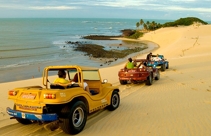
|
45 km north of Natal. The adventure starts already at the hotel, leaving in the buggies. Our destination is one of the most famous local attractions, the sand dunes of Genipabú. After passing by the Via Costeira, Meio, Artistas and fortress beaches we´ll reach the ferryboat which will take us to the north coast over the Potengí River. Arriving at Redinha beach we start our tour with much emotion aiming the fixed dunes where we can also go on a dromedary back riding. We´ll also sail over another river called ceará Mirim, on a very small ferryboat, used by the locals. Driving to the north passing by several wild beaches, we are going to reach the jacumã lake, where on hanging cable chairs you will try on of the highlights of this excursion the “aerobunda” , hanging on these cables you will slide down to the warm and clean water. And can also try the “eskibunda”, a kind of sandboard reaching the water as well. After all this we will take you to the restaurant. After lunch we continue the tour. On the way back we stop at pitangui lake for a couple of minutes and keep further to the movable dunes. With or without emotion are the only options we have to go up and down on these dunes. After the dunes we return to Natal. |
Pipa Beach
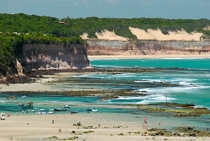
|
Located 85km to the south of Natal, there is Pipa beach, a complete paradise for nature lovers. On our way, we will visit the city of São José de Minibu and we will stop at the public market to appreciate everything that local men get from the generous nature and what they make out of it: fruit, vegetables, fresh fish, brown sugar candy and an amazing variety of typical dishes and snacks. We continue to the Pipa Ecological Sanctuary where exotic species live entirely free in the exuberant Atlantic forest: small monkeys, all kinds of tropical birds, dolphins and marine turtles. Stop for bathing and Madeiro beach and lunch. In the afternoon we shall visit the arts and crafts market offering a great variety of handmade jewelry and religious ornaments. There are several optional tours available while the tour will be in Pipa beach, featuring boat tours and horse riding. Those alternative tours may also be replacing the above mentioned visits. Return to Natal late afternoon. |
Barra de Cunhaú
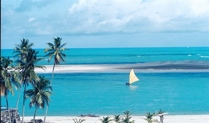 |
90 km south of Natal. Cunhaú is a fascinating and old fishing village. Nowadays, one of the most important shrimp production centre of the country, exporting to several countries of the world. Reaching Barra de Cunhaú, there is a boat ride towards the mangroove region, where the sea life begins. At the mangrove you will get to know the importance of this place for nature and for humankind. You can also try to catch the “Sá” crabs very much appreciated by the local people and tourists.
|
SOUTH COAST
Among numerous beaches compounding the south coast it is important to emphasize Pirangi, Buzios, Barra de Cunhaú and Baía Formosa beaches. From these the nearest from Natal is localized at Parnamirim county at 21 km from it and is called North Pirangi. It is the shelter of the biggest cashew of the world and it is opened to visits, and natural pools 800 meters from coast. Before Pirangi is Cotovelo beach, quiet with low waves, good for swimming. Still in the Rota do Sol, a road linking Ponta Negra to the south coast, lies the Barreira do Inferno, a rocket launching base opened to public to casual visits.
At 23 km from Natal in the south coast is localized Buzios beach in the Nísia Floresta county, which its mainly visitants are the surfers because its high waves. The access is from Rota do Sol. Now, who prefers or practice some sport like windsurf or kitesurf has its fun guaranteed by South Pirangi and Pirambuzios beaches because its mild waves. These beaches are localized after Buzios, and right before the same one is Barra de Tabatinga with a special attention to the Dolphin Observatory at the top of a cliff providing a great visual of the sea and the dunes.
To south yet the beaches of Cumurupim and Barreta are localized with its reefs making seaside natural pools in low tide. In Camurupim is localized the Arituba lagoon with fresh water good for swimming and places with bars and restaurants margining the lagoon. In south coast yet there is Barra de Cunhaú, a fisher village neighboring Pipa beach and recently has drawn a lot of tourist who came seeking peace. The region of Barra de Cunhaú is important because the shrimp farms, and the restaurants offer good menu options with shrimps and fish. The inns are small but it is setting up others offering comfortable chalets and rooms.
Finishing the south coast we introduce Baia Formosa, surrounded bay cliffs and dunes, localized only at 93 km from Natal. This beach is just starting to be discovered by tourists, perfect to the ones who seek peace and nature. The access to this beach is from the BR-101, direction Natal-João Pessoa and it’s about 22 km from BR-101 to the beach.
NORTH COAST
The north coast is more extensive and exposes a greater number of beaches. The most visited are Genipabu, Jacumã, Maracajaú, Barra de Punaú, Perobas, São Miguel do Gostoso, Galinhos, Macau and Ponta do Mel.
At 25 km from Natal it is localized the most famous beach of the State, Genipabu. The buggy excursions on the dunes to see the beautiful view of its lagoon is one of the most important touristic attraction of the State. The access is from north zone or by raft on Potengi river.
Genipabu dunes are such a rollercoaster with guaranteed fun in the radicals maneuvers make by the professional buggy drivers (professionals allowed by the State to realize this kind of excursion). Beyond the traditional raft excursions and the “skibunda” there is a differential, the camel excursions to make the fun complete.
At 33 km from Natal, flanked by reefs making the waves lower and good for swimming, lies Jacumã. Its access is by BR-101 toward Touros county. Its dunes and lagoon with the famous “aerobunda” and “skibunda” are the principal attraction there. Leading north there are the Porto Mirim, with lots of coconut trees, and Muriu offering seaside bars.
In Maracajaú, localized in Maxaranguape county, the mainly attraction are the parrachos, a coral formations just at 7 km from the coast. Maracajaú, 54 km from Natal, has landscape shaped by dunes, lagoons and coconut trees and the access is by BR-101 until Natal-Touros. From the Igapó bridge are 49 km by BR-101 until the rotatory return. After it there are more 5 km of asphalted road until the beach.
Yet in Maxaranguape the biggest attraction is the love tree localized near the end of the cape of São Roque, the side of Brazil nearest from Africa.
Now the Galinhos region, 160 km from Natal, has drawn attention of the tourist seeking new touristic destines almost non-explored, far from the daily turmoil. Dunes, salt lakes and mangroves make a landscape that enchants the tourist. The Galinhos village is uncommon, it doesn’t has automobilist transit, and cart pull up by horses or donkeys makes a different scenery.
Rio Grande do Norte Information and Fast Facts
Country: Brazil
Population: approximately 3.3 million
Language: Portuguese
Area: 20,390 square miles / 52,810 square kilometres
Main administrative centre: Natal
Biggest city: Natal (approximately 900,000 population)